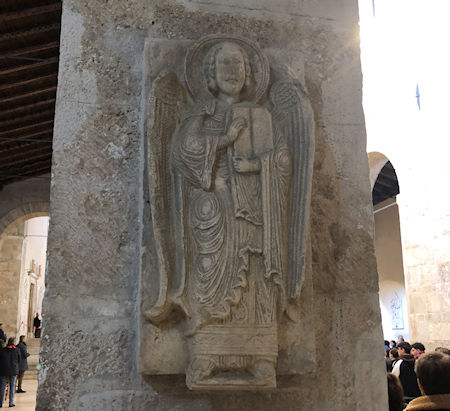You may not find this terribly rewarding unless you're included here, so this is a good time for casual and random browsers to turn back before they get too caught up in the sweep and majesty of the proceedings and can't let go.
We're not based in Europe anymore, and we've struggled through the covid-19 lockdowns like everyone else, so we haven't set foot in Italy since February 2019. Now we're making up for lost time with mad sightseeing, but missing the cats even more sorely as the days fly by.
A few days ago we sought out a few villages to the north of Ascoli Viceno -- now it's time for a few to the
south (21 November 2022).
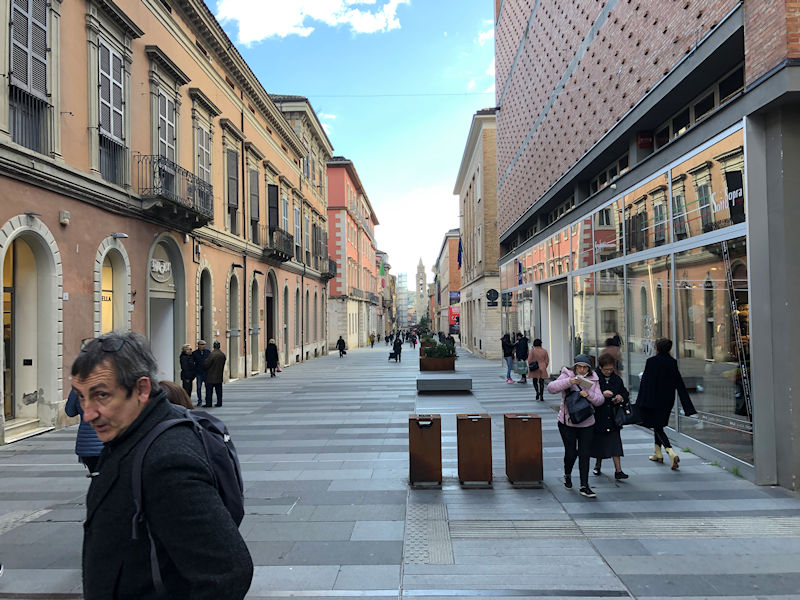
Teramo, capital of Teramo province, Abruzzo region: This is the Corso San Giorgio main pedestrian thoroughfare from the roundabout at the Piazza Giuseppe Garibaldi straight ahead to the Cattedrale di Santa Maria Assunta. Teramo is a quite modern city of some 54,000 souls, all of which that we saw laid out in a modern grid style with not much sign of medieval higgledy-piggledy alleys all over. The city's name derives from a Greek term meaning the confluence of two rivers, in this case the Vezzola and the Tordino.
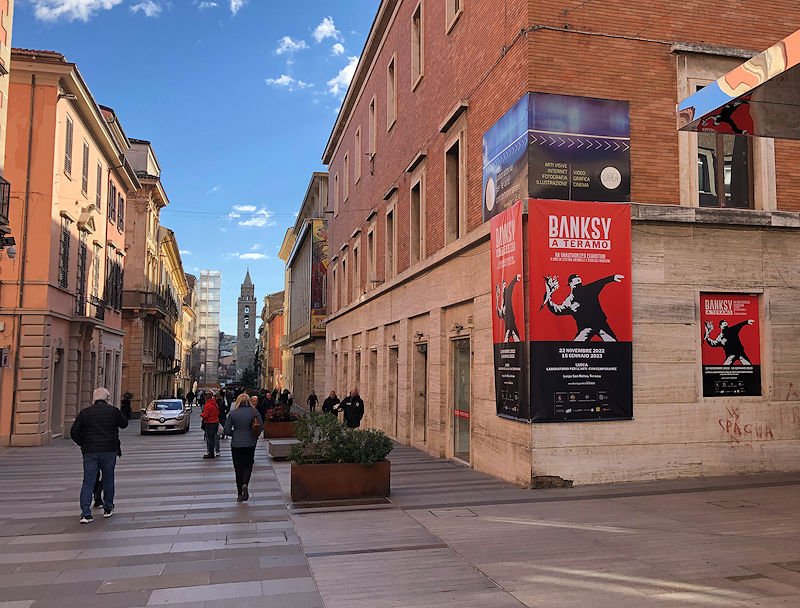
The early city was occupied by Roman legions at the end of the Third Samnite War in 290 BC, and in the first century BC it was given the status of Municipium, a town or city considered to be part of the Roman state, under which it prospered with all of the baths, theatres, and temples of a proper Roman city. In the early Middle Ages, however, it was destroyed by Alaric's Visigoths in AD 410, became a possession of the Byzantine Excharate of Ravenna, and then a Lombard fief under the Duchy of Spoleto.

It was conquered by the Normans in the mid-12th century, and all but destroyed by one of them in the process, then administered by the Hohenstaufen Emperor Frederick II until the mid-13th century, next by the French Anjou dynasty and eventually by the Angevin and then Aragonese Kingdoms of Naples until in the 18th century it was granted to the Austrian Habsburgs, followed by the Spanish Bourbons -- until Napoleon's army overcame stiff resistance from the citizen militia in 1798 and sacked the whole city once again.

In June 1943 the Germany army arrived and occupied the city, but on 25 June the Germans battled the local Resistance fighters in the forest of Bosco Martese in the mountains to the west. It's said to have been the first open-field action of the Resistance against the Germans in Italy.
A number of carabinieri commanders organized a military band that quickly grew to over 1,600 men, soldiers of the recently dissolved Italian army, escaped Allied prisoners, Slavs, and many young civilians, and at the Bosco Martese they attacked a German division. The Germans withdrew, though in the following weeks they carried out several reprisals, but we're told that the news of the action contributed greatly to the development of the wider Resistance movement.
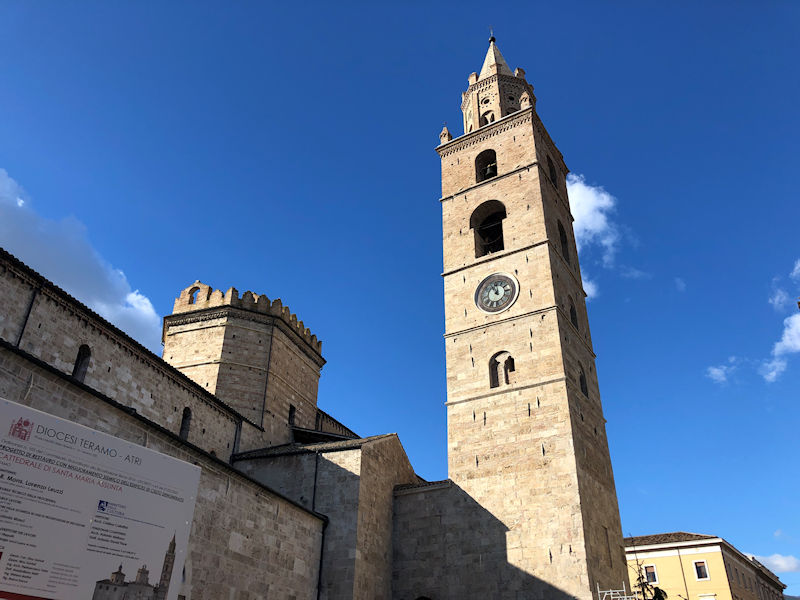
The Duomo di Teramo, aka the Cathedral of Santa Maria Assunta, is dedicated to the Assumption of the Virgin Mary and to the patron saint of the city, Saint Berardo, a local nobleman who served as bishop here from 1116 to 1123. It's said that several miracles are attributed to him, most notably when he and the Virgin Mary worked together to liberate Teramo from an early 14th century siege by the Duke of Atri of the Aquaviva family. He was apparently instrumental in making (temporary) peace amongst the warring factions of the city, especially the families of De Valle and Melatino.
The lower section of the belltower dates from the 12th and 13th centuries, the middle section from the 14th, and the octagonal 'lantern' on the top was designed in 1493.

[When we'd come round to the eastern end, the front end, of the Duomo, the front steps were crowded with apparently high-ranking carabinieri officers in full dress uniforms, gathered for some sort of ceremony inside. We were doubtful about photographing the cathedral façade at the moment in case they'd want us to delete our photos (which happened in Lodi a few years ago), so in order to provide some context, we called upon the Creative Commons once again. (Photo by Luca Aless, July 2016, under the Wikipedia Creative Commons)]

A very impressive church it is. It was begun in 1158 by bishop Guido to house the relics of St Berardo after its predecessor church was destroyed by the Norman rogue Robert III of Loritello three years earlier. It was consecrated in 1176, a Romanesque structure with a nave and two aisles and a raised presbytery, with much of the stonework scavenged from the nearby Roman amphitheatre. In the early-mid 14th century it was modified and enlarged in a Gothic style, with a separate façade round at the back end, and in the 18th century it was all much modified again to conform with Baroque styles; happily, the medieval appearance was restored in the 1930s.
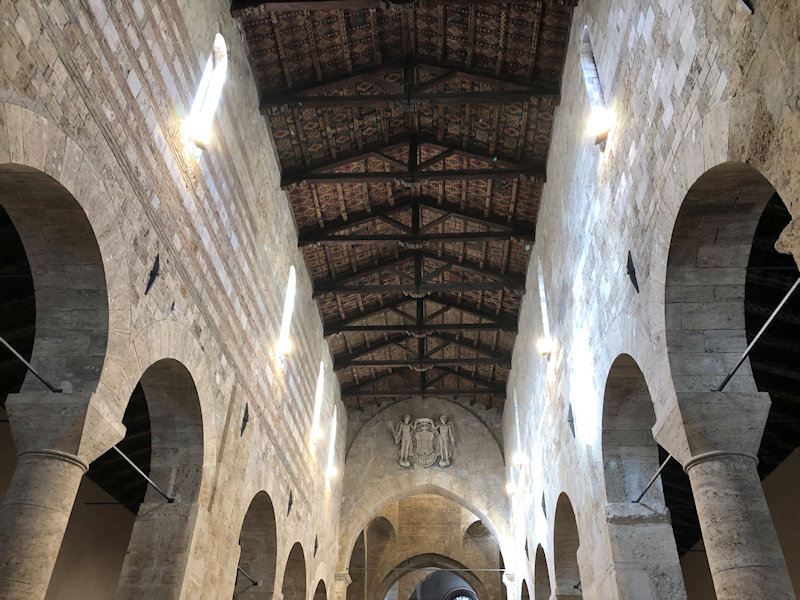

Some serious observances are about to get under way (we'll hurry up a little).
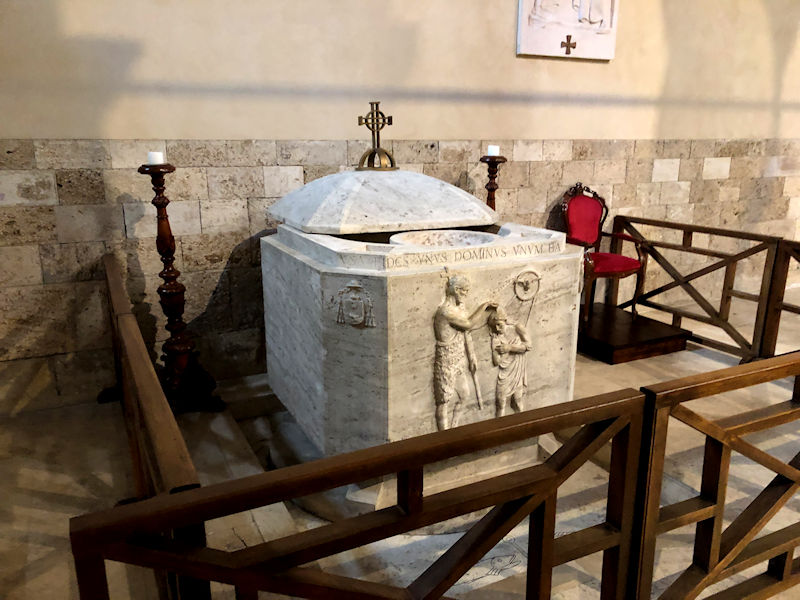
A baptismal font
And here are some interesting early art works near the back of the church -- the guidebooks tell of quite a few impressive works strewn all about the place, altarpieces and an altar frontal (aka an antependium) of the high altar, an early 15th century polyptych by Jacobello del Fiore, and a 14th century wooden crucifix (probably the one hanging off the left wall just below), etc., but . . .

. . . it's not a wise choice for us to elbow in amongst the celebrants and go browsing for all that stuff.
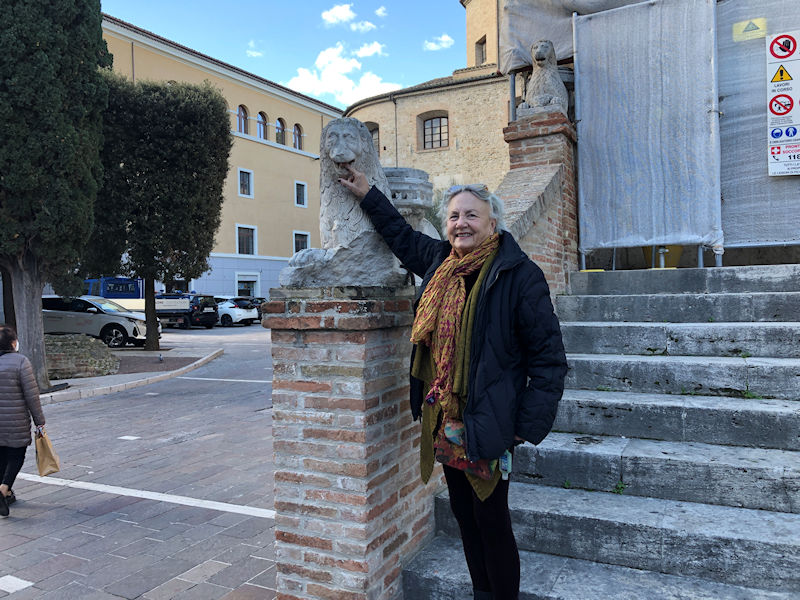
This is a photo that cried out not to be missed -- it's for our collection of commemorative pictures on Kristin with her hand in an Italian marble lion's mouth.

That's a Roman theatre just across the street from the cathedral, and there are also some remains of the plundered amphitheatre round the side of the church as well.
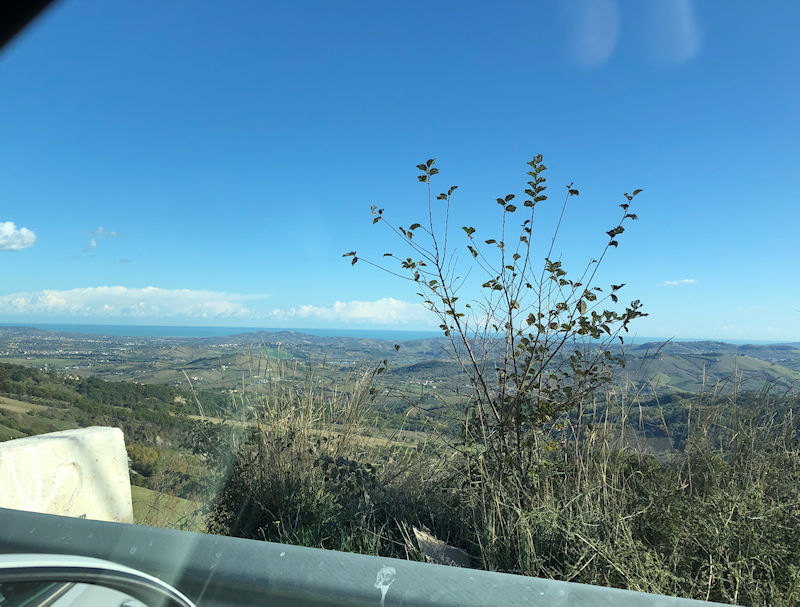
We're on the road again, in this instance gazing out at the Adriatic Sea, all except the driver, of course (actually the driver's gazing at it, too). Teramo seems like a worthy town, with all its own charms, including a University of Teramo beginning in 1993, facilitated by the opening of the 10km highway tunnel under the Gran Sasso in 1984, that has cultivated what the Bradt's guidebook calls 'a thriving little city with a healthy student population'. To be honest, however . . .

. . . some of our party noticed this interesting feature of the landscape as we were driving out to Teramo, and we have a unanimous consensus that this might be a more interesting place to investigate.

On the top of a classic hilltop town cascading down the sides of it, there is this enormous something-or-other which invites all kinds of speculation.
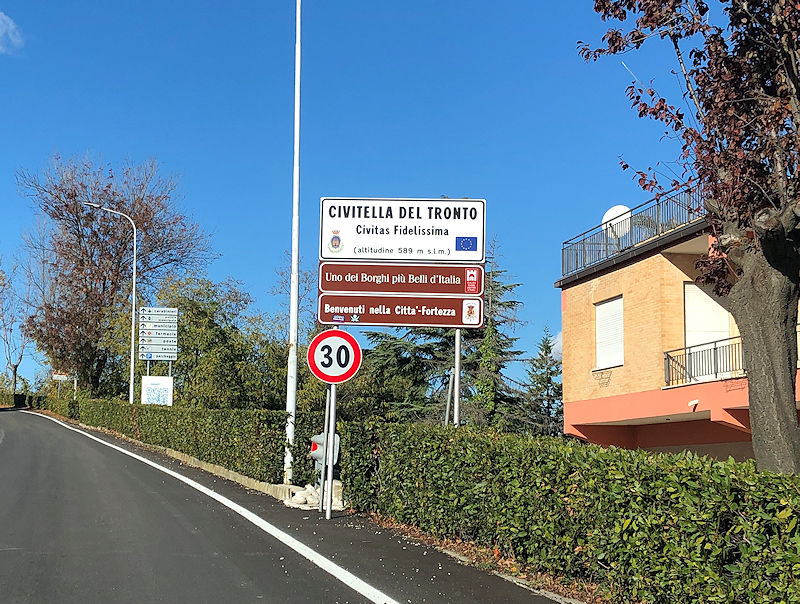
So we're entering Civitella del Tronto, and from this we learn that though we're still in the Abruzzo region, we're back in the watershed of the Tronto river, that the town has been awarded the designation of 'one of the most beautiful villages in Italy' [in 2012], and that the huge thing stuck up on top of the hill is the Fortezza.
The designation of 'Fidelissima' was bestowed by King Philip II of Spain, then the overlord of the 'Regno' of southern Italy, in recognition of Civitella having successfully resisted a siege by French troops in 1557.
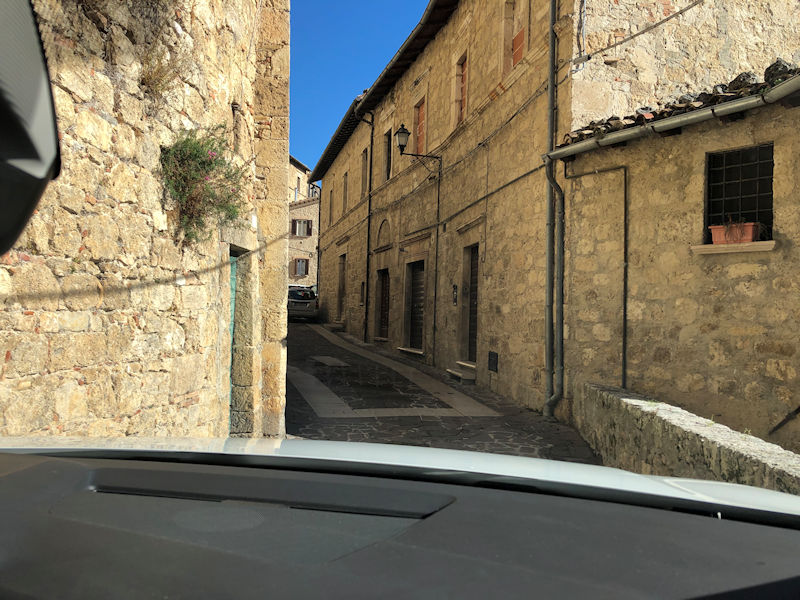
Possibly we've missed a turning -- things are getting very crowded now. It's about half the width of our Mitsibushi battle-tank, but now even this tiny VW Golf is beginning to tremble in doubt.

This has been a worsening situation for some time now -- what we really need is a place to turn the car around. Backing up is not to be considered.
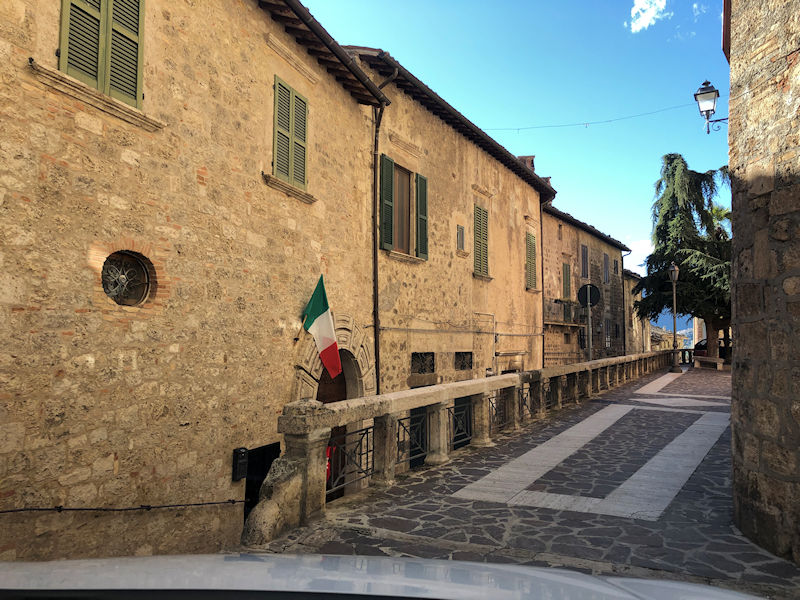
-- Turn it around here!
-- What? Are you crazy?
-- It's either that or abandon the car!

We're hooked on the curb now. Oh rats. Ironically, we learned subsequently that Silvia's parruchiera is on a sort-of-a-street called the Corso Giuseppe Mazzini, which is the name of the main street in Ascoli Piceno.

Man, did we have that one wrong! Next time we'll follow the signs.
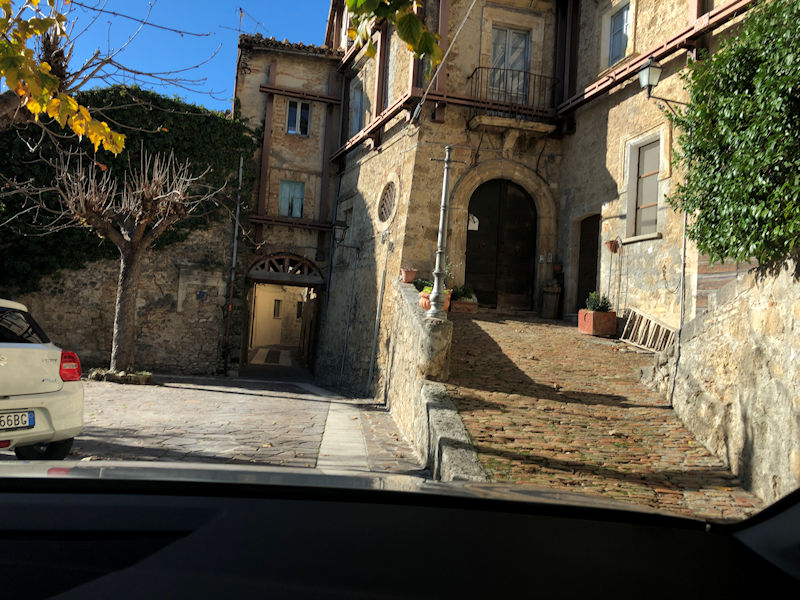
But first we need to find the signs. This is a village of a bit more than 5,000 'Civitellesi' as they insist upon calling themselves. And with St Ubald as their patron saint. It's not for us to judge.
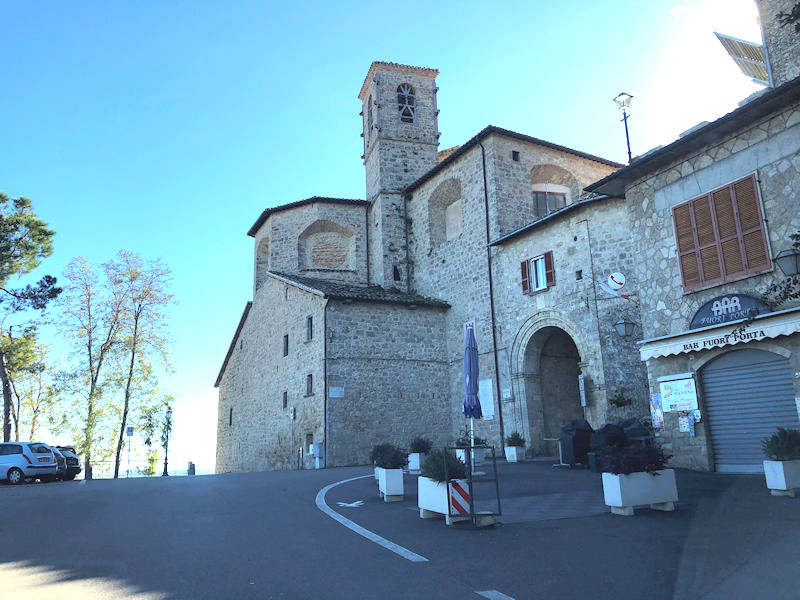
Bingo, here's the impressive gateway through the upper town's walls, the Porta Napoli, alongside the Chiesa di S Lorenzo, the back end of which is sticking out at us.
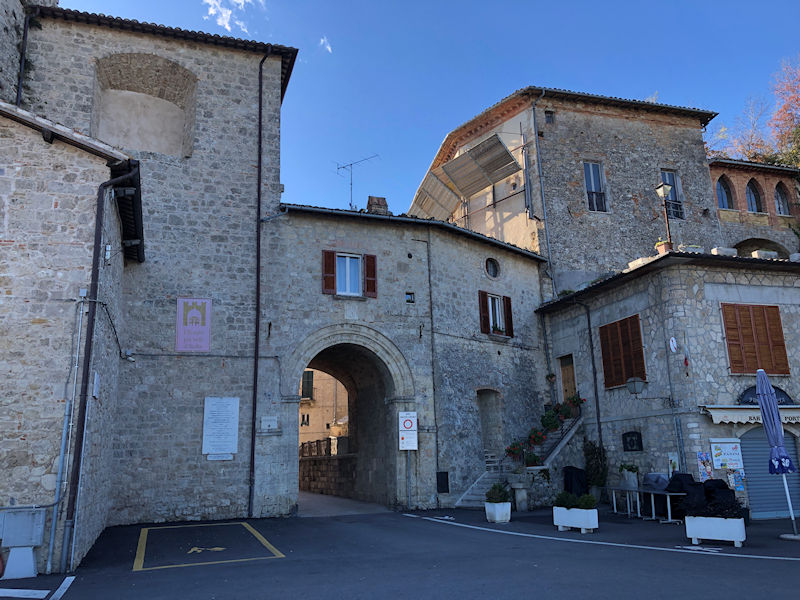
We dump the car -- we've learnt that lesson right enough -- and strike off on foot to find out what's on offer.
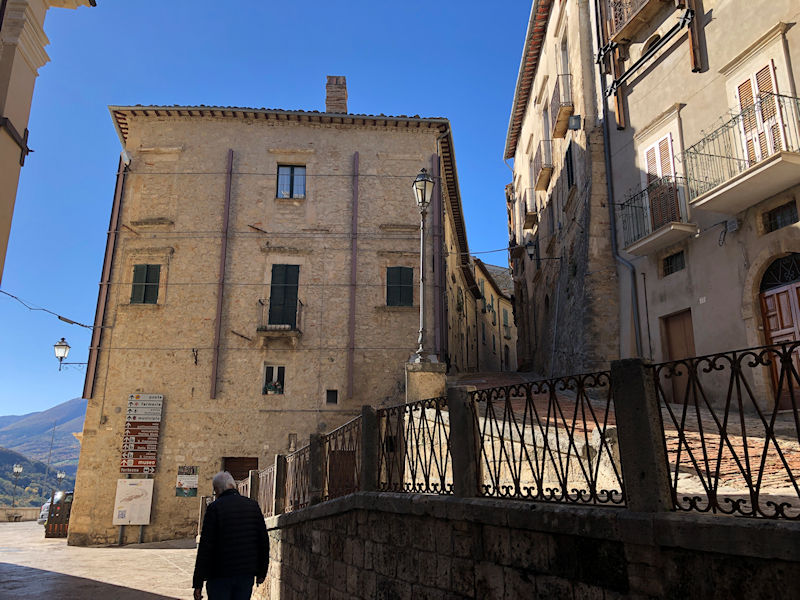
It's all very exciting -- it's giving off all the best signs of presenting us with an hour or two of pretend-medieval fun.

The Civitella is within the Gran Sasso e Monti della Laga National Park -- up there!

Oscar and Cathy reviewing our prospects, on a civic balcony overlooking the village with medieval buildings at either end -- to us, it's reminiscent of Gubbio.

We're standing in the Piazza Franciscus Filippi Pepe, from which everything is extremely . . .

. . . scenic.

We're off on a hunt for the Fortezza, though (once again) we seem to have missed the appropriate signs; it's all improvisatory now.

This ought to be helpful -- right now we're about where that red dot has conveniently popped up, and the message for us is clear: It's UP.
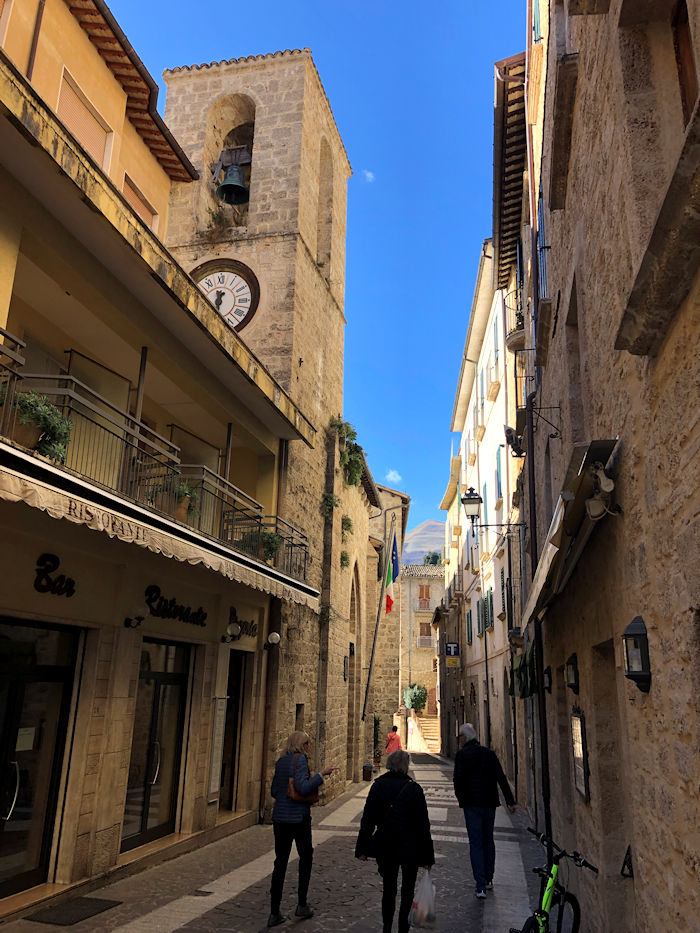
But how? Where?
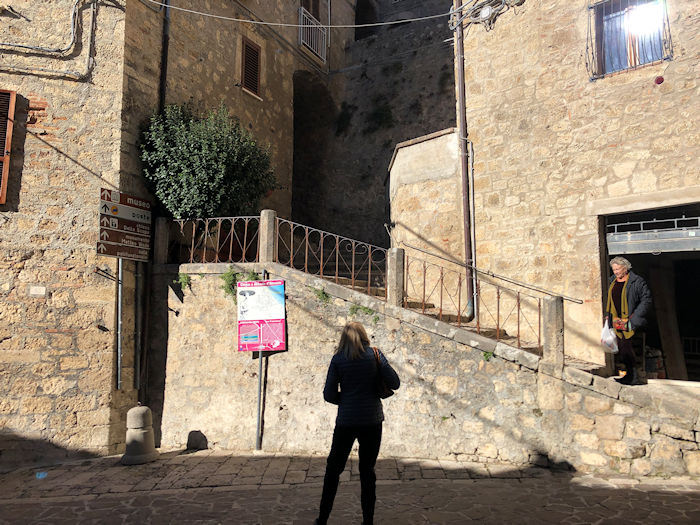
UP!
-- What have we got to lose?
-- Are you kidding?

Oh, okay then.
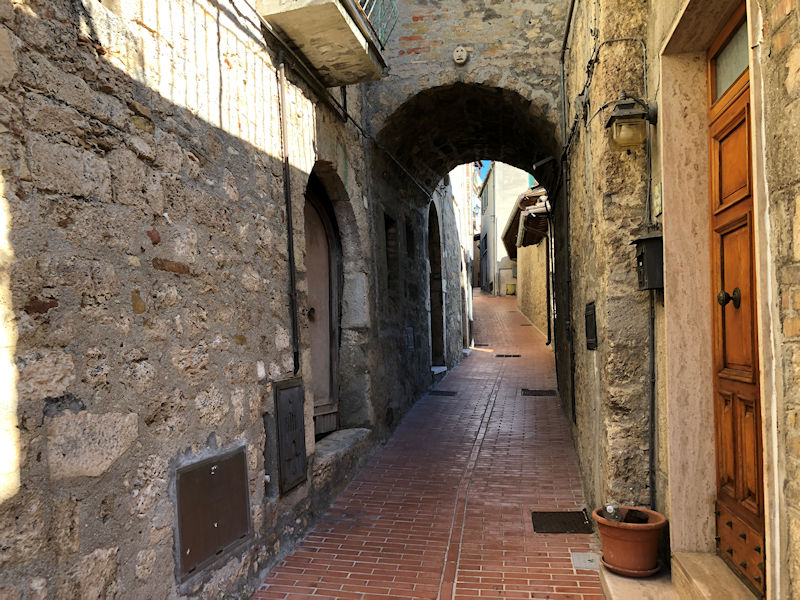
Charming in the extreme . . . but what now?
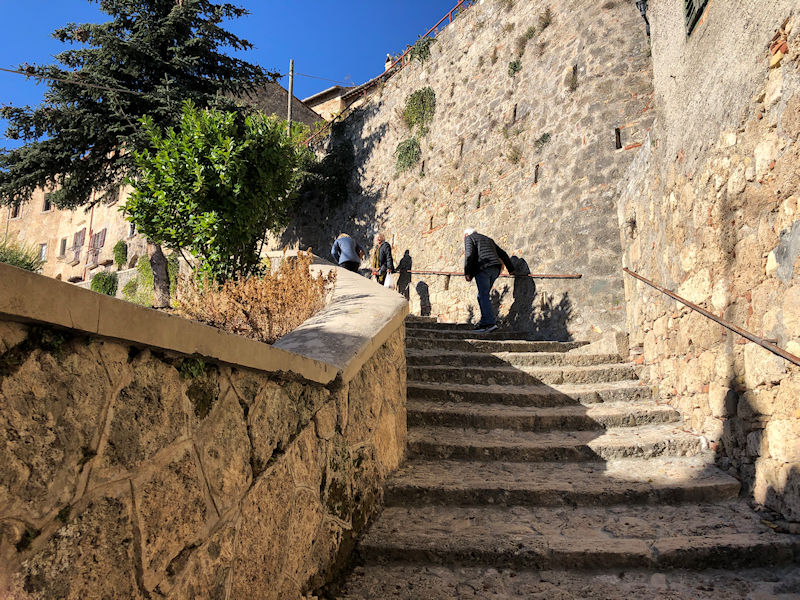
UP!
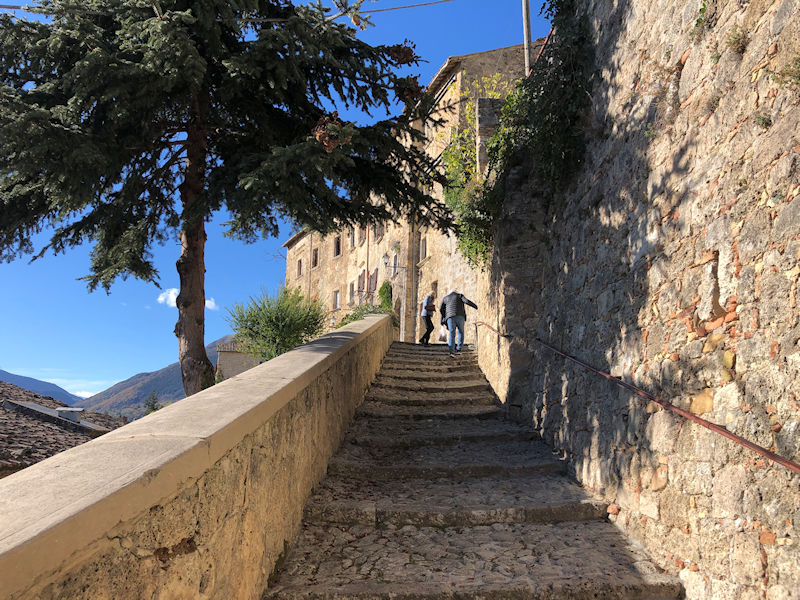
What do these people do with their weekly shopping?
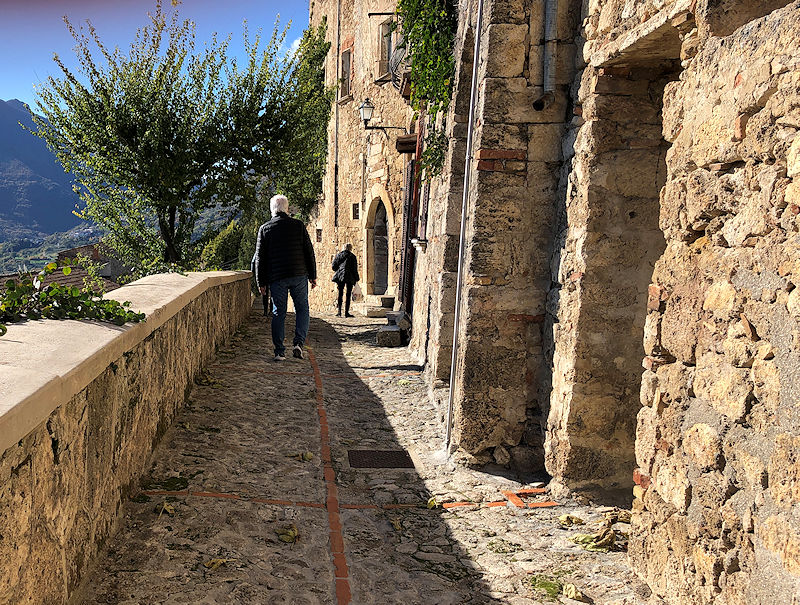
A brief but welcome breathing space
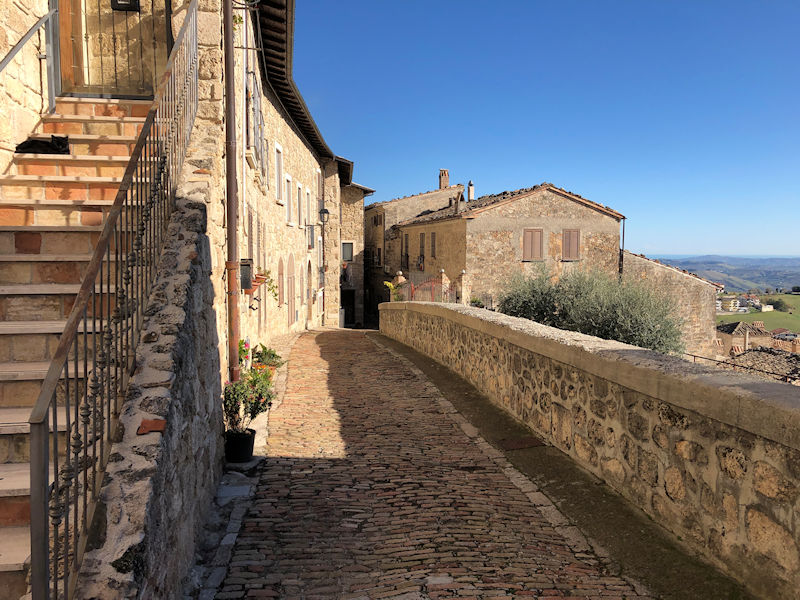

More up! Attacking armies were probably pretty discouraged by this time.
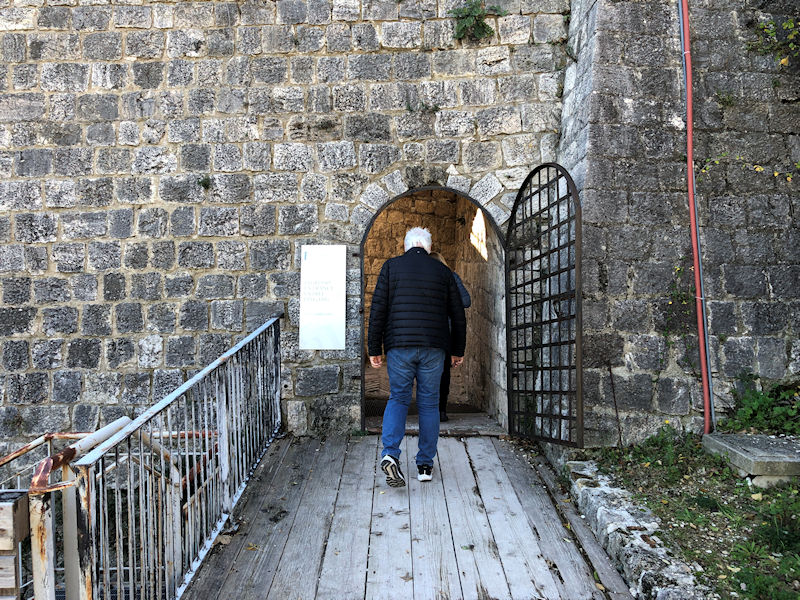
A promising door
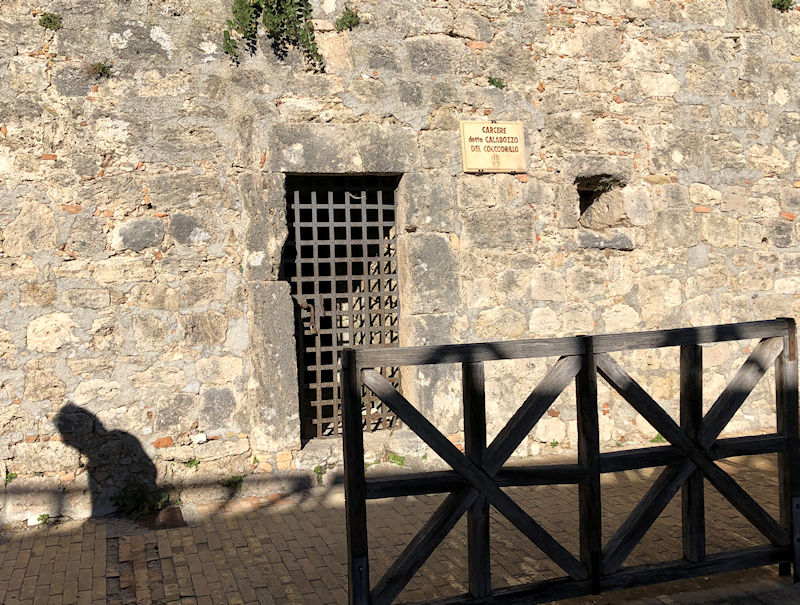
The fort's prison (at least it's not down in the dank dungeons, with rats)
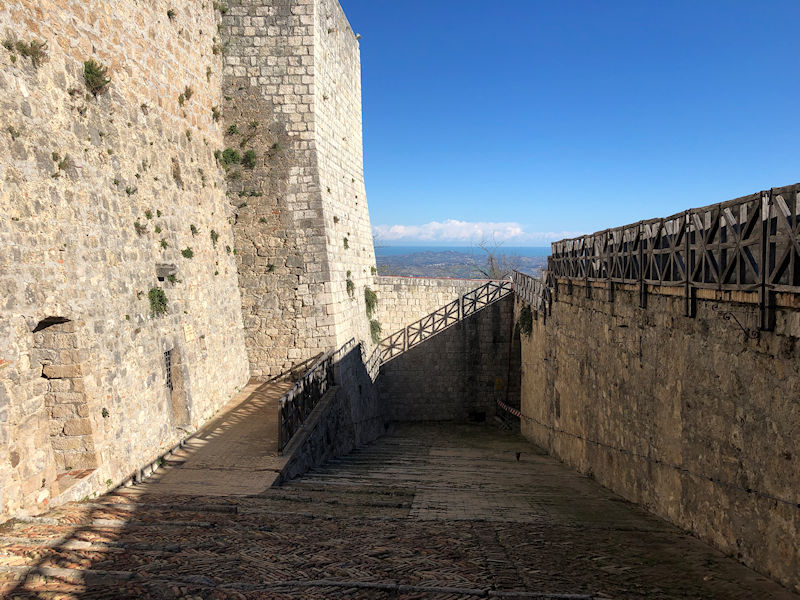
That's the Adriatic Sea in the distance, BTW.
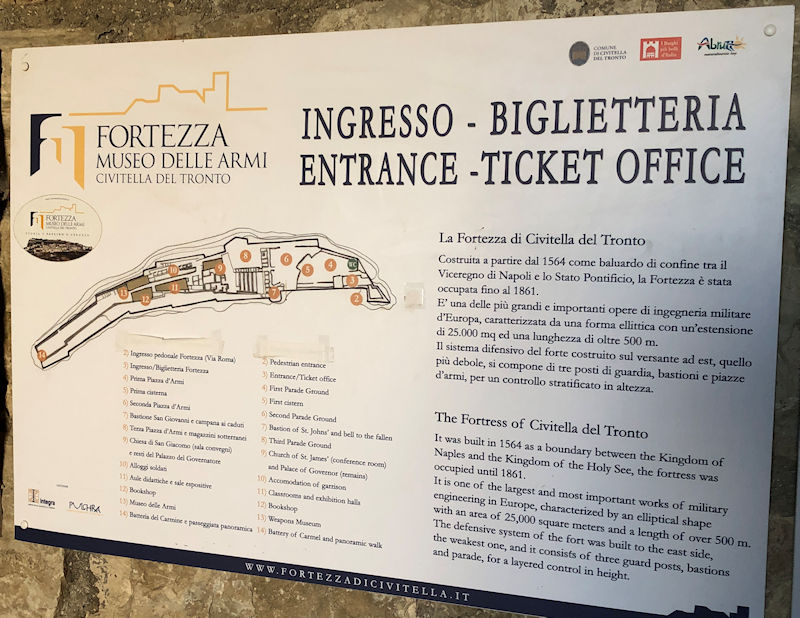
It looks as if 4, 6, and 8 are all parade grounds. That's a lot of parading, no?
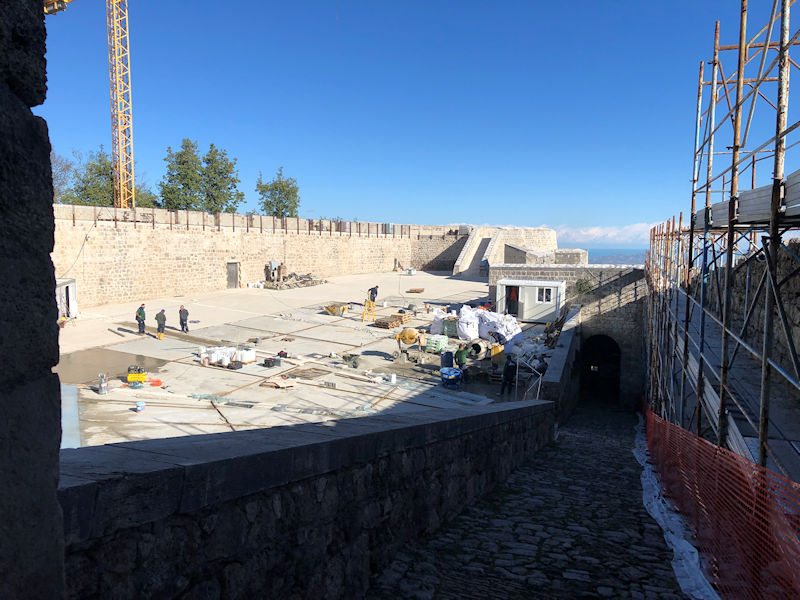
That's Parade Ground 1, getting an entirely new flooring. The building of the fortress began in 1564 and lasted around 12 years; its purpose was to clarify the boundary between the Kingdom of Naples and the Papal States. It was occupied until 1861, when Italian unification made it surplus to requirements. It's had restoration works performed over time, but this appears to be a major project now.

The layout we saw above identifies this as the Bastion of St John and the bell to the fallen.
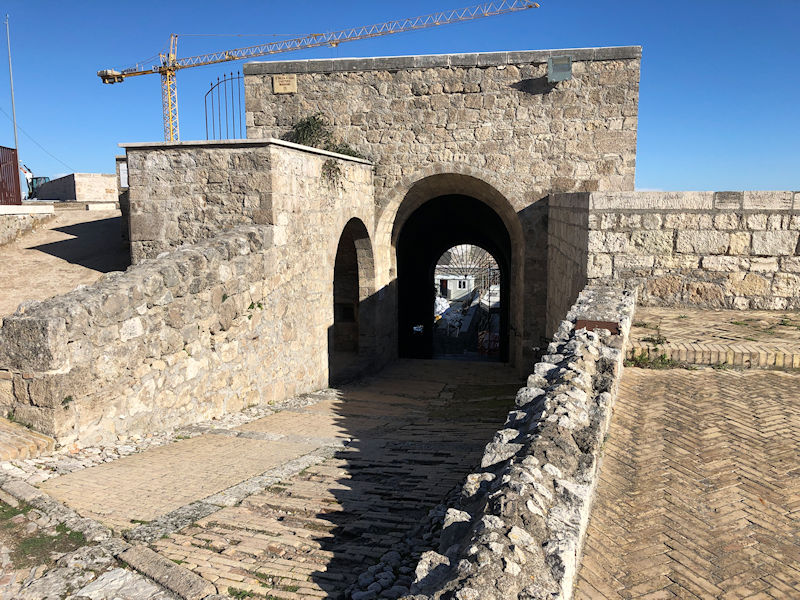
Up to the major installations along the top of the western end of the fort.
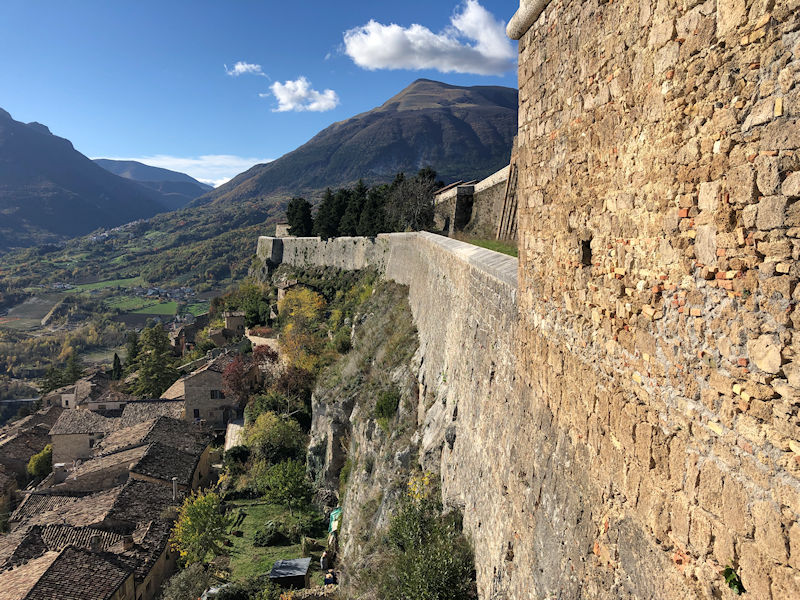
No wonder it withstood so many sieges. (It was even besieged twice more by the French during the Napoleonic Wars, but the second time, in 1806, it did surrender after four months. After Napoleon's fall, in 1816 the Congress of Vienna annexed it to the Kingdom of the Two Sicilies, and it was the site of the last stand of that Bourbon Kingdom before the forces of the pro-unification army of Piedmontese and Garibaldine troops; it surrendered in March 1861 and was absorbed into the new Kingdom of Italy but decommissioned.)

If you're a young soldier who's got to sit around in a fortress garrison, you could have drawn a much worse place for it.

The top tier is still a ruin, though there is an active array of a Weapons Museum, Exhibition Halls, Classrooms, and a Bookshop normally operating back through somewhere. We didn't have time to explore it very much, as it's time for lunch.
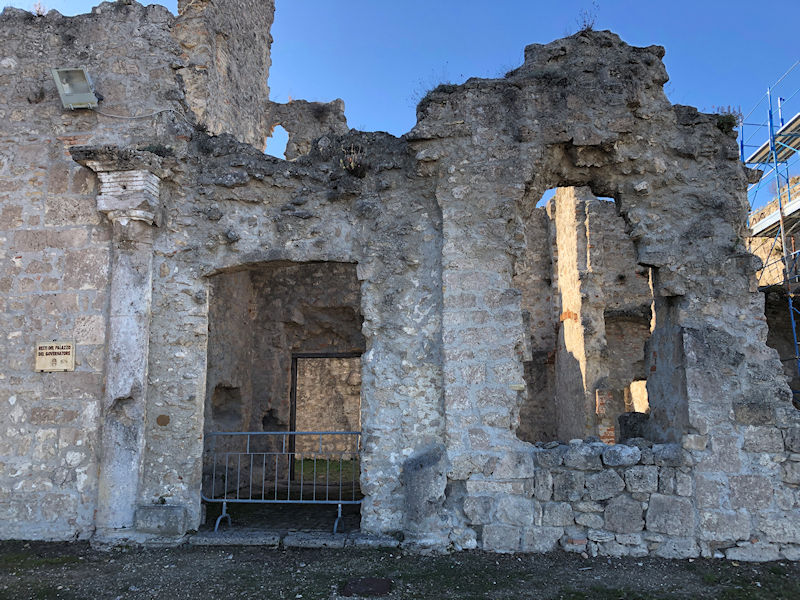
That's signed as the remains of the Palazzo of the Fort's Governor. We don't know whether the present restoration works are just for safety maintenance or will later be building these things back up into a facsimile of the originals.
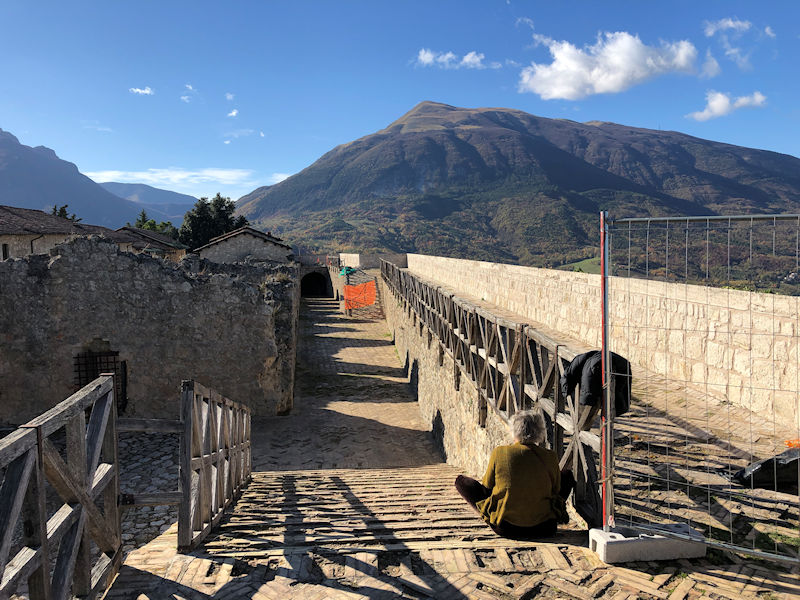
Kristin's breaking out the sandwiches and iced tea stash. Line up and proceed in an orderly fashion.

The remains, now a museum, with formerly the barracks for the garrison as well

Down we go. Ouch, ouch -- up wasn't so bad, but down!

Ouch. Ouch.
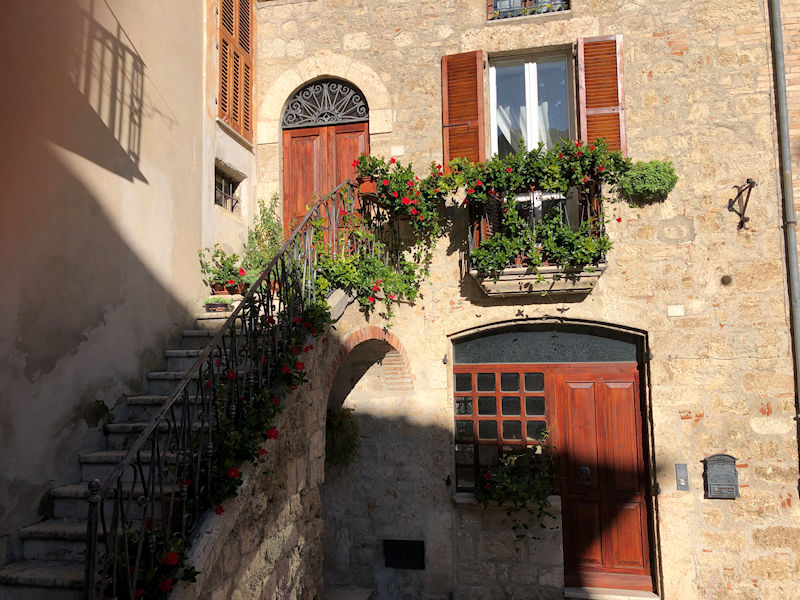
A festive welcome back to the Porta Napoli

'Uno dei Borghi più Belli d'Italia'. No kidding.

The Porta Napoli
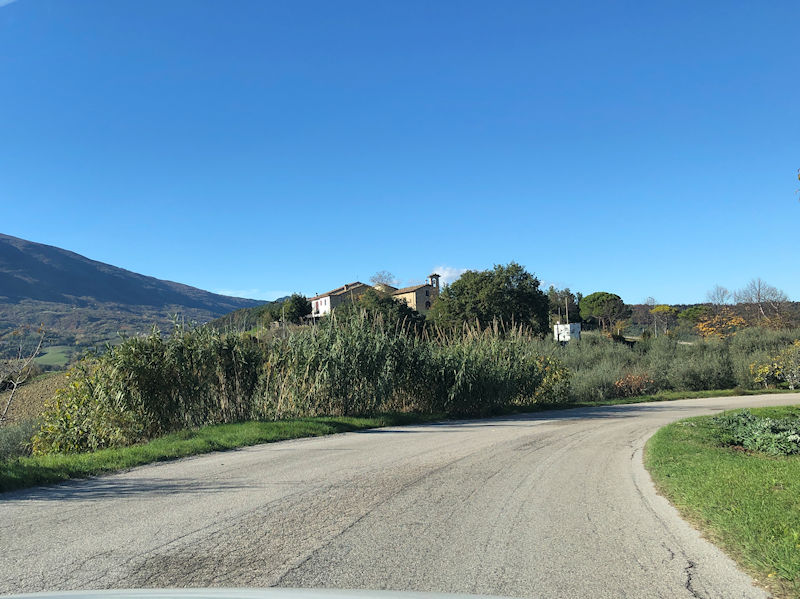
The rural road back to the Marche Region, Ascoli Piceno Province, and . . .
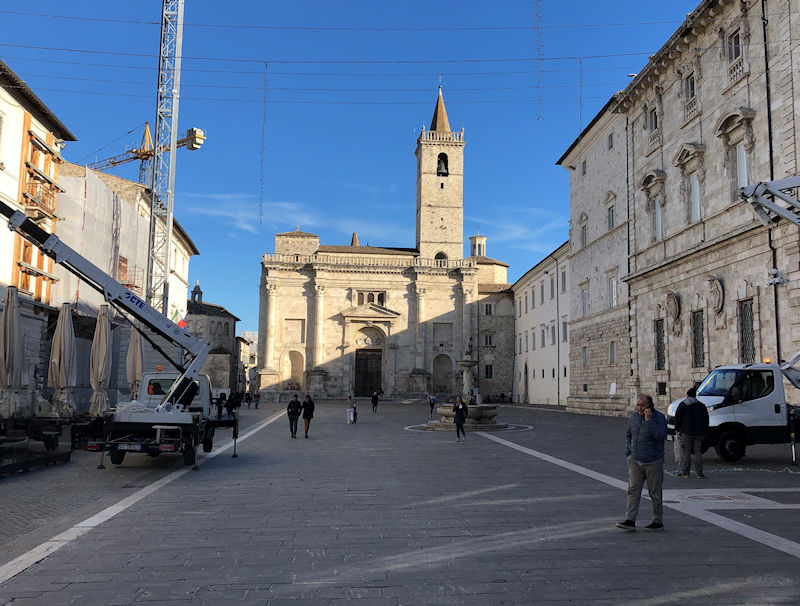
. . . the familiar Piazza Arringo.
-- Welcome home, kids! -- Thanks, glad to be back.
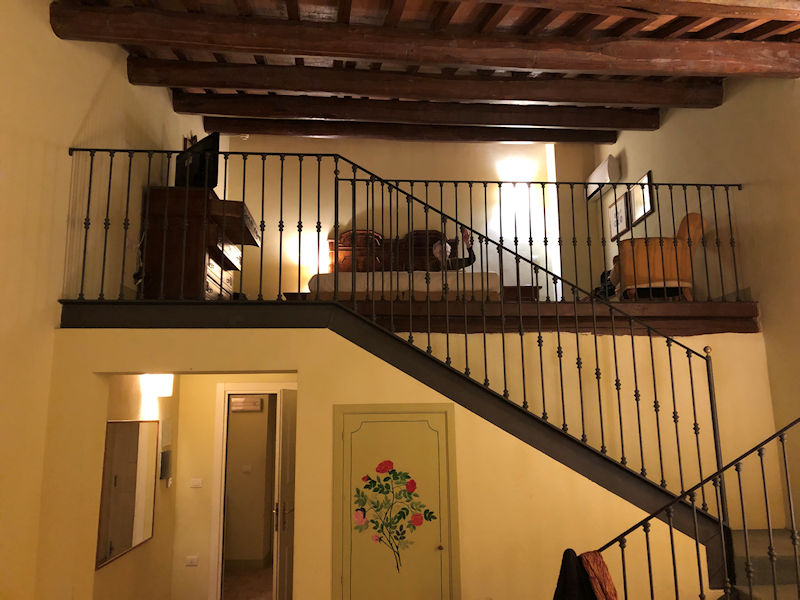
We've got an even better new room assignment in the Hotel Guiderocchi for our last few days.
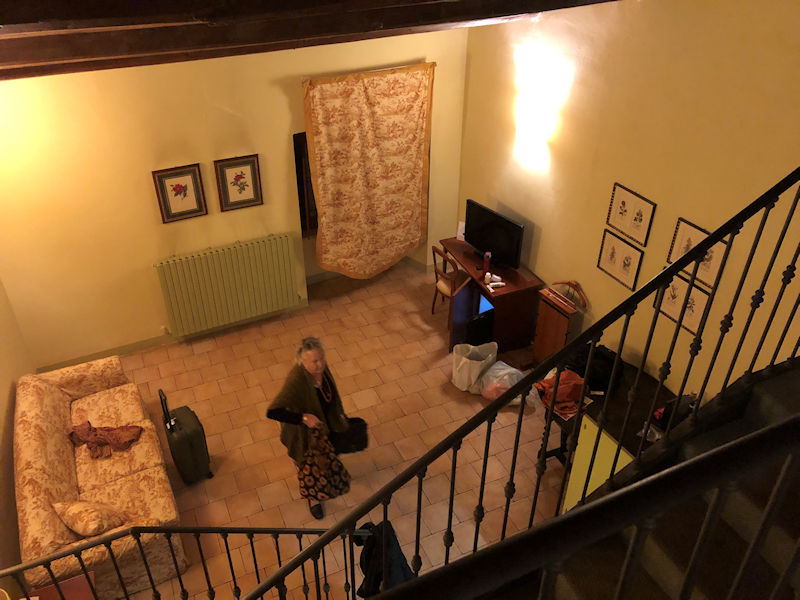
It's only the prospect of late-night stairs that does slightly disconcert one.
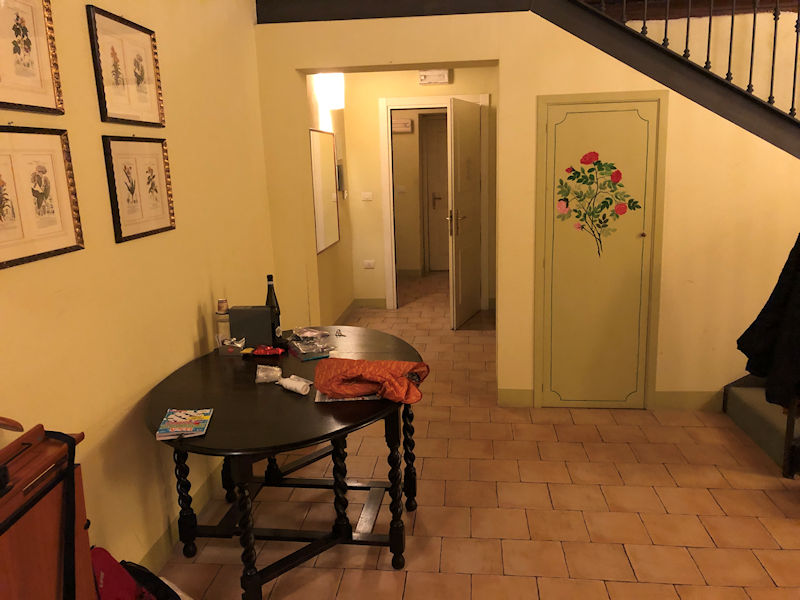
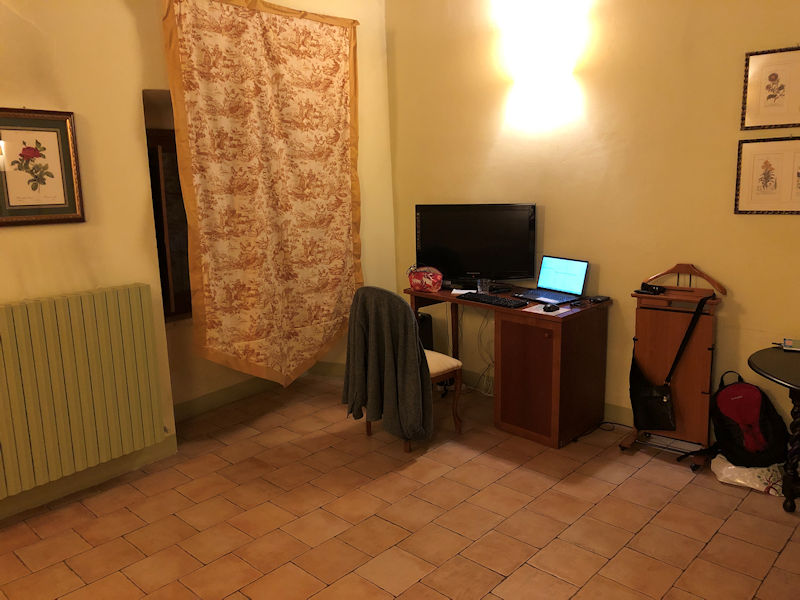
That serves as a temporary study, and . . .

. . . we've got our favorite Birra Moretti for getting on with.

Tonight we're in the Locanda Imperfetta, over in the towers district of Ascoli
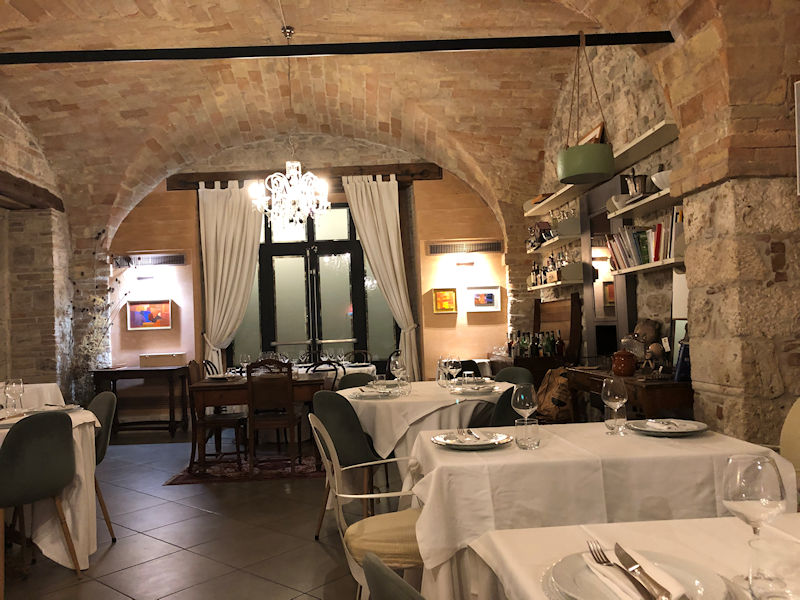
A beautiful place, though . . .
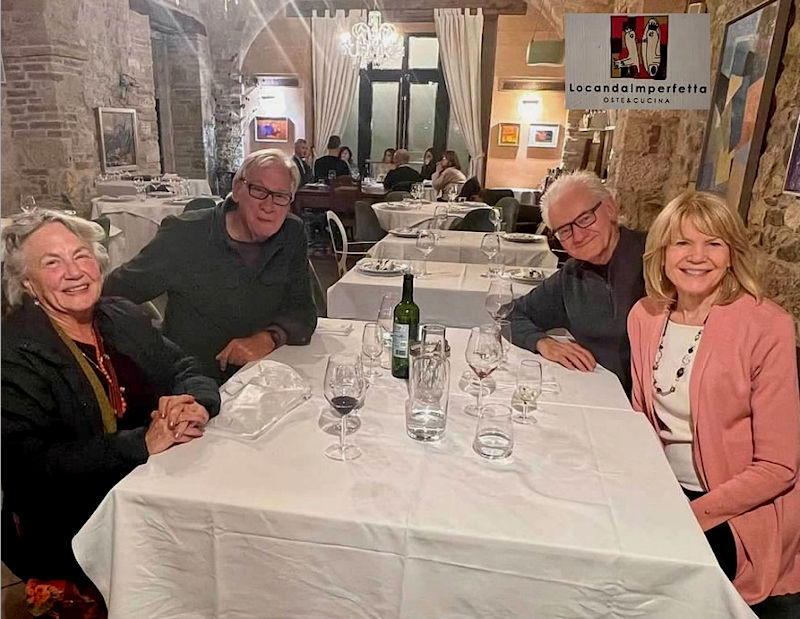
. . . not as beautiful as this, one of two groups in the establishment tonight.
 Dwight Peck's personal website
Dwight Peck's personal website










